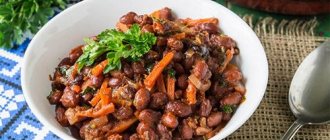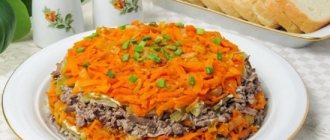Among legume crops in terms of sown area, beans rank second in the world after peas . It is especially grown in Brazil, Mexico, the USA, Bulgaria, Romania and Hungary. The high popularity of this culture is explained by its excellent taste and nutritional qualities, as well as the fact that a wide variety of dishes can be prepared from it.
Bean varieties. Common beans
Rachelle - with white seeds. Tolerates drought, waterlogging, and short-term cold snaps. Forms up to 35 flat beans 16 cm long. The homeland of all types of beans is Central and South America. The seeds of this one of the main food crops of the Aztecs and Mayans were found in Mexico in burials of the 12th-15th centuries. Of the Europeans, the Spaniards were the first to become acquainted with beans, then the Germans and the French. In Russia, beans, which were called Turkish beans because they were brought from Turkey and Georgia, have been known since the 17th century. At first it was used exclusively as an ornamental crop. However, by the end of the 18th century, peasants of the Yaroslavl province, as well as Klin and Tver gardeners, specially grew vegetable beans in greenhouses for sale in Moscow and St. Petersburg.
Today, the main crops grown are multifloral, lima, golden (mung bean), angular (adzuki) and common beans . We’ll talk about the last one, the least thermophilic, today. The common bean is grown as a grain and vegetable . Its ripened seeds contain at least 25% protein (for comparison: in meat it is 20%, in fish -18%), and it is soluble in water and is easily digestible. Unlike animal proteins, bean proteins are rich in essential amino acids . Unripe beans and bean seeds accumulate 4 times less protein, but are rich in carbohydrates, mineral salts of calcium and iron, vitamins A, K, C, PP and group B, flavonoids and organic acids. Therefore, beans, especially vegetable beans, are a dietary product ; they are recommended for liver diseases and metabolic disorders. A decoction of common beans reduces blood sugar levels. A decoction of bean leaves helps with rheumatism, edema of renal origin and caused by heart failure. The same decoction is recommended for urolithiasis, cystitis, gout, and in an equal mixture with a decoction of blueberry leaves - for diseases of the pancreas.
Beans are also used as a fodder, ornamental crop and green fertilizer , since, thanks to the nodule bacteria that live on the roots, they enrich the soil with nitrogen .
Climbing beans are distinguished - with unlimited growth of stems (2 m or more); semi-curly - with limited growth, up to 1.5 m, and curling tops; bush - with a branching stem 30-60 cm high, ending in a flower raceme. Among bush beans, there are varieties with compact and spreading bushes . The first ones are early ripening, with the beans located high (10 cm) above the ground, the second ones have a longer growing season. The leaves of the plants are alternate, trifoliate. The shoots and leaves are pubescent, their color can be yellow, green, dark green, with or without an anthocyanin tint. There are from 2 to 12 flowers in a flower brush. Varieties with white bean seeds have a white flower color, with black ones - light pink, with brown and yellow - bright pink. Often the sail of a flower is colored more intensely than the wings.
Delicious preparation for the winter
Canned products occupy a special place on the table of our compatriots. Let's get acquainted with a simple recipe for making red bean lobio. It is usually used to preserve food for the winter.
The dish consists of components:
- ripe tomatoes;
- beans (traditionally red);
- medium sized carrots;
- white onion;
- winter garlic;
- pepper (ground);
- several branches of fresh cilantro;
- salt;
- additional seasonings (optional);
- sunflower oil.
According to the Georgian recipe, the beans are soaked for 12 hours. After this, it is washed and cooked until tender.
Grate the carrots using a grater with large sections. The onion is cut into squares, the garlic is passed through a garlic press. Heat oil in a frying pan. First add chopped onions. Fry until light brown. Add carrots. Stir and simmer over low heat until orange juice appears.
Tomatoes are cut into pieces. Then grind with a blender. The mass is poured into a saucepan and put on fire. Cook for 15 minutes. Add salt, spices, herbs. Then the sauce is poured into the pan. Stir. Boil over low heat. Combine with beans. Cover with a lid and cook for another 30 minutes.
Suitable containers are sterilized over steam. Fill it with the mixture and seal with metal lids. The finished snack prepared for the winter is stored in a cool room. Served with meat dishes, porridge and mashed potatoes.
Description of beans
The vegetable bean fruit is a bean (straight, curved, saber-shaped, crescent-shaped), flat or round in cross section. In shelled varieties, the bean walls contain a thick, rough parchment layer. Therefore, such beans are eaten raw only when the beans are just forming. In semi-sugar varieties this layer is weak or forms late, and in sugar varieties it is in the form of a longitudinal fiber along the seam or is completely absent (asparagus beans). The most delicious vegetable beans are those whose beans are round , with fleshy leaves, without a parchment layer, and with small and medium-sized seeds.
The bean contains up to 10 seeds. The weight of 1000 seeds ranges from 200 to 600 g. Collected in dry weather with a humidity of no more than 15%, they remain viable for 5-7 years, although they gradually lose moisture and shine and become dark and brown.
In tandem with poultry meat
To make the vegetable dish a little more filling, add meat. The proposed recipe for red bean lobio in Georgian will resemble the national dish of the Brazilian people, called feijoada.
To prepare it you need to masterfully combine:
- chicken breast;
- red beans;
- onions and juicy carrots;
- garlic and chili pepper;
- spicy adjika;
- “Khmeli-Suneli” (dry seasoning);
- ground black pepper;
- greens (a fragrant mixture of parsley and cilantro);
- salt;
- vegetable oil (needed for frying).
Cook the soaked beans until soft, about 90 minutes. The fire should be moderate.
Chicken fillet is cut into equal pieces. Fry in a frying pan until done.
The onion is peeled. Chop into cubes. Carrots and peppers are cut into strips. Fry alternately in sunflower oil for about 10 minutes. The prepared ingredients are placed in a large container. Seasoned with adjika. Salted. Sprinkle with seasonings. Decorate with greens.
Lobio with chicken is served warm.
Where is the best place to plant beans?
BEANS are a short-day plant; they require light and are heat-loving. Seeds begin to germinate at a temperature of 10-15°, seedlings die when the temperature drops to 0°, and the optimal temperature for growth and development is 20-25°. At low temperatures and high humidity, as well as with a sharp change in day and night temperatures, plants are severely affected by diseases. Under such conditions, the formation of fruits and the ripening of seeds is significantly delayed, then they are poorly stored and quickly lose their germination capacity. In addition, if the area is flooded, bean plants die within four days. Beans also cannot tolerate heat and drought. For its germination, soil moisture must be at least 80%, and dry winds cause buds, flowers and young ovaries to fall off, so watering is necessary during drought. Still, beans can grow anywhere , the main thing is to choose the right variety based on the duration of warm weather in your region. New bush varieties (35-50 cm high), mid-season and mid-early varieties (40-45 days from germination to harvesting and 70-85 days for grain) are most adapted to Russian conditions.
VEGETABLE beans are given more fertile places than peas. On acidic, depleted soils that float after rain or with close groundwater, vegetable beans grow poorly, are often damaged by diseases, and the beans become coarser and smaller. It is better to place it on light loams filled with organic matter on southern or southwestern slopes, protected from cold northern winds. In the Non-Black Earth zone, areas should be well warmed up and illuminated by the sun. In the south of Russia and in the black earth zone, beans can be placed in the inter-rows of an orchard or vineyard and compacted with cabbage, potatoes, beets, and cucumbers. However, you should not combine beans with celery and onions.
The roots of beans are mainly concentrated in a soil layer 20-25 cm deep, so it is important to dig the soil deeply in the fall, having previously scattered phosphorus-potassium fertilizer (6-8 g of each element/sq.m.). Acidic areas are limed (0.5-0.7 kg of chalk/sq.m), soddy-podzolic and gray forest soils are filled with manure (2-4 kg/sq.m). In spring, the soil is harrowed a week before and immediately before sowing, adding 5-10 g of nitrogen/1 sq.m of bed. Microelements - boron, molybdenum, zinc - are added to the rows when sowing in the form of fertilizers.
How and when to sow beans
Sowing of beans begins when the soil at a depth of 10 cm warms up to 12°. Beans are sown to a depth of 1-2 cm, in two- or three-line ribbons with an interval of 35 cm and with a distance between plants of 15 cm. If the sowing is kept for about 1.5 months under film, the crop will ripen 2-3 weeks earlier. You can protect plants from frost and get early production by growing beans through seedlings.
The soil is rolled or compacted with the back of a rake; heavy soil is mulched to prevent the formation of a crust, which causes the bean seedlings to break at the loop stage. Caring for crops: loosening the soil (three to four times per season), weeding (until the plants close) and providing support (stakes, netting, twine) for climbing and semi-climbing varieties. If the soil is infertile, when a pair of true leaves grow, the beans are fed with complete mineral fertilizer.
Spicy delicacy with nut sauce
Typically, seasonings are used to cook meat to give it a savory taste. In the popular Georgian recipe for red bean lobio, spices occupy a special place.
The spicy dish is prepared from a non-standard set of products:
- boiled or canned beans;
- juicy onions;
- walnut kernels;
- garlic;
- wine vinegar;
- mixture of ground peppers;
- aromatic coriander;
- table salt;
- sunflower oil.
Finely chopped onion is fried in sunflower oil until golden brown. Garlic is cut into thin slices. Place in a bowl. Add coriander and stir. Walnut kernels are removed from the shell.
Place in a mortar and crush using a masher. Next, the product is mixed with garlic and coriander. Add wine vinegar.
When the onion reaches the desired texture, add boiled or canned beans to the pan. Stir and fry for about 10 minutes. Then season with nut sauce and spices. Simmer over moderate heat for another 15 minutes. The finished delicacy is sprinkled with chopped herbs.
As you can see, the classic red bean lobio recipe is quite simple to prepare. First, the necessary ingredients are collected. Then they clean, chop, fry and combine in a spacious container. Season with spices and serve. Enjoy a delicious dish made with your own hands.









